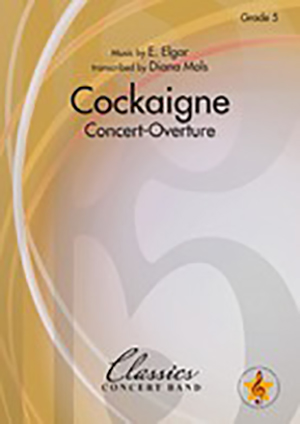Cockaigne Overture
| Sound File | |
|---|---|
| Sample Score | SHOW PDF |
| Composer | Elgar, Edward |
| Arranger | Mols, Diana |
| Instumentation | Concert Band |
| Grade | 5 |
| Duration | 15:00 |
| Genre | Concert Music |
| Included Parts | |
| Format | DIN A3 |
| Article | SMP-10-0056 |
- Description
Description
Cockaigne (In London Town), Op. 40, also known as the Cockaigne Overture, is a concert overture for full orchestra composed by the British composer Edward Elgar in 1900-01.In its 15 minutes or so the overture gives a lively and colourful musical portrait of Edwardian London. ‘Cockaigne’ was a term used by moralists at that time as a metaphor for gluttony and drunkenness, while Britain adopted the name humorously for London. There is no narrative programme, but the work presents various aspects of turn-of-the-century London and Londoners. It begins with a quiet but bustling theme which leads into an unbroken sequence of snapshots: the cockneys, the church bells, the romantic couples, a slightly ragged brass band (perhaps the Salvation Army) and a contrastingly grand and imperious military band. The broad theme representing Londoners is, Michael Kennedy states, the first occurrence of Elgar’s trademark direction, ‘nobilmente’. The work ends in a characteristically Elgarian blaze of orchestral sound.Mindful, perhaps, of the way Elgar brings his themes together at the climax of the piece, both Bernard Shaw and W.H. “Billy” Reed compared the work to Richard Wagner’s Die Meistersinger von Nürnberg Prelude, which culminates in the combination of several themes. Shaw, in a long article on Elgar in 1920, wrote:“But if you say that Elgar’s Cockaigne overture combines every classic quality of a concert overture with every lyrical and dramatic quality of the overture to Die Meistersinger, you are either uttering a platitude as safe as a compliment to Handel on the majesty of the “Hallelujah” Chorus, or else damning yourself to all critical posterity by uttering a gaffe that will make your grandson blush for you. Personally, I am prepared to take the risk. What do I care for my grandson? Give me Cockaigne.” Reed wrote: “The Cockaigne Overture does not eclipse the Mastersingers prelude, but neither is it outshone by Wagner’s most symphonically satisfying introductory composition from which it actually borrows some procedures. Elgar’s piece is as splendidly evocative a picture of Edwardian London as Wagner’s is of medieval Nuremberg, and there is nothing to choose between the two in humour, mastery of construction and appositeness of scoring.” At the age of six Diana (1980) started attending violin lessons at the local school of music in Heerlen.When she was twelve she started playing the flute. After a few years of taking private lessons, she was admitted at the Academy of Music in Maastricht and attended the lessons by René Kravanja and Peter Rijkx. After two years of Maastricht she attended her first degree course at the Academy of Arts in Utrecht by Nine Sligter, where she passed her Bachelor exam for performing musician in 2005 with distinction. At the Conservatory in Maastricht she got her degree Master of Music with the grade 9 at Peter Rijkx in 2007.Diana has attended masterclasses by Koos Verheul, Emily Beynon, Gaby Pas-van Riet, Carlo Jans,Maartje Marsman, Carin Levine, Vincent Cortvrint and others.Diana is regularly performing in concerts at home and abroad, both as an orchestral musician and as a soloist. She has been on concert tours in the Netherlands, Germany, Austria, Switzerland, Latvia, the U.S.A. (Carnegie Hall New York), Canada and China. She performed as a soloist with, among other orchestras, the National Youth Wind Orchestra at the World Music Contest in Kerkrade in 2005 and she played in Musis Sacrum in Arnhem at the International Choir Festival. Diana also played in the National Youth Orchestra at the position of solopiccolo. Since January 2008 she has a steady position as piccolo player at the Royal Netherlands Army Band “Johan Willem Friso”.Dians also showed growth on other musical fields. She played five years as a mallet player at the percussion ensemble of the Royal Wind Orchestra of Thorn and two years as a viola player in the Groninger Student Orchestra “Mira”. Since september 2010 she has been playing viola at the Chamberorchestra der Aa Groningen and the ‘Veenkoloniaal’ symphonyorchestra Wildervank. For eight years Diana was the solo flutist in the National Youth Wind Orchestra. Last but not least since september 2009 she is the conductor from Windorchestra ‘Eendracht’ Assen and actif as an arranger.


